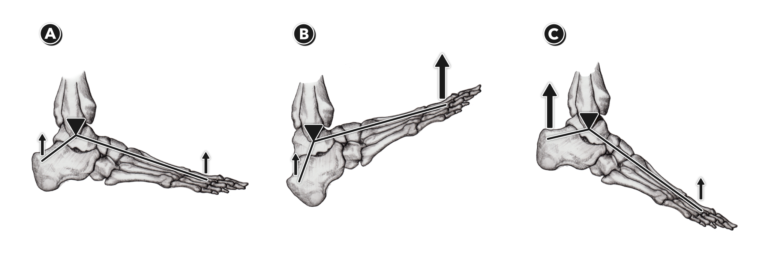A first-class lever is a very simple machine comprised of a beam placed upon a fulcrum. A load is placed onto one end of a beam, while an effort is directed onto the other end to counter the load.
When viewing the illustrations, arrows indicate the direction of forces applied. Differences in arrow size indicate differences in the magnitude of forces applied. The movement of the beam of the lever (the stick) is indicated by directional tilt.
If the load and effort are of the same magnitude, then no movement occurs (Figure 1A). The system is in equilibrium. If the effort expended is larger than the load, then the end of the beam receiving the effort moves in the direction of that effort’s application (Figure 1B). If the load applied is larger than the effort applied to the beam, then the loaded end will move in the direction opposite to the applied effort (Figure 1C).
One of the most commonly used examples of first-class levers in human anatomy is the skull as it sits atop the first vertebra (the atlas). This unique joint allows the skull to nod forward and backward and side to side, acting as a first-class lever where the neck musculature provides the opposing forces.
Just as in the simple machine illustrated in Fig. 1, when the muscular effort expended using the posterior and anterior neck musculature is of the same magnitude, the system is in equilibrium and the head stays in an erect posture (Figure 2A). If the muscular force generated by the anterior musculature is greater than that generated by the posterior musculature, the head nods forward (Figure 2B). If the muscular force generated by the posterior musculature is greater than that generated by the anterior musculature, the head nods rearward (Figure 2C).
A first-class lever can also be suspended, much as we see in the scales held in the sculpture “Scales of Justice.” An example of this in the human body is the relationship between the ankle and foot. If we hold the foot off the ground, the ankle is the fulcrum and the foot is the beam, suspended in the air via the tibia and fibula.
Again, as in the simple machine, if the force generated by the posterior calf muscles (gastrocnemius, soleus, plantaris) is of the same magnitude as that generated by the anterior shin muscle (tibialis anterior), then an equilibrium exists and there is no movement (Figure 3A). If the muscular force generated by the anterior musculature is greater than that generated by the posterior musculature, the forefoot and toes rise forward (Figure 3B). If the muscular force generated by the posterior musculature is greater than that generated by the anterior musculature, the heel of the foot rises rearward (Figure 3C).
Related
“Anatomy of Levers, Part 1”
“Anatomy of Levers, Part 2”
“Anatomy of Levers, Part 3”
“Anatomy of Levers, Part 4”
“Anatomy of Levers, Part 5”
“Anatomy of Levers, Part 6”
Comments on Levers Article 1
Is there a relationship with balance to find his load in order to have intensity in his training? or I'm wrong?
I am not sure if this is about levers. But you are right there is a right weight to maximize intensity. Just like there is a right weight if you want to through a ball far. A foam ball won’t go far, a metal ball will be too heavy and a baseball ball is the ideal weight to be thrown far. So everyone will have a ideal weight to maximize their relative intensity in a given workout, and at a given capacity. Please refer to relative intensity in the definition of CrossFit in the level 1 training guide.
I learned this in elementary school, apply it to the anatomy for training is great
CrossFit is the science of fitness, and now we explore the science of movement,better known as physics. Thank you.
Looking for ward to the rest of the material.
Scaling at its finest. Appreciate the illustrational work. I’m new to the Sport and am glad to see the behind the scenes prep.
Really like this - so useful to have the physics laid out - looking forward to the continuation of this series.
Great Article! This is an effective way to understand movements using science and engineering. Excellent!



Anatomy of Levers, Part 1: First-Class Levers
8